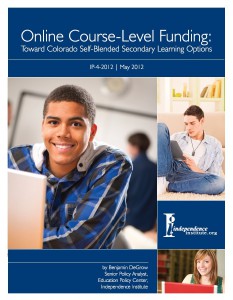IP-4-2012 (May 2012)
Author: Ben DeGrow
PDF of full Issue Paper
Scribd version of full Issue Paper
Executive Summary
Many Colorado secondary students may benefit from greater opportunity to take a number of traditional face-to-face classes and digital courses simultaneously. Students’ ability to “self-blend” courses in this manner is hampered by school district control of per-pupil funding and course options. Following the national Digital Learning Council’s guidelines, Colorado should alter the K-12 education funding system to enable greater student access to effective online course options.
State tax dollars make up the largest share of Colorado’s K-12 funding, including the School Finance Act’s Per-Pupil Revenue (PPR) formula, various categorical programs, and school construction grants. Personnel policies and central programs largely dictate how education dollars flow through district offices to individual learning sites. Students enrolled full-time in a multi-district online program receive less PPR than traditional district students. Students enrolled full-time in a single-district online program bring in the same PPR as a full-time brick-and-mortar student. Even in cases where students can access courses through an outside provider, district authority narrows the available field of providers. Colorado Online, the state’s largest supplemental online provider, receives a line-item subsidy from the legislature in addition to individual course enrollment fees from districts.
A few states have enacted funding systems that allow secondary students to customize course-level learning–including Florida, Minnesota and Idaho. Utah’s new Statewide Online Education Program provides the best example of student-driven, course-level blended learning. A similar system could operate effectively in Colorado as follows:
- Funds should be distributed to schools based on multiple count dates rather the current single October 1 enrollment count, using school membership rather than attendance;
- Dollars should be divided beyond full-time and part-time to reach the course level, using a tiered funding structure to differentiate costs based on course content;
- PPR and categorical funds should be combined and allotted to individual K-12 students, weighted according to need, and directed to their chosen school and/or courses; and
- At least 50 percent of funding should be given to providers only after successful course completion, with bonuses contemplated for measurable excellent achievement.
To balance concerns, the state also should contract with an outside entity to monitor and report on course and provider outcomes. Two significant barriers to a student-centered, course-level funding system are the lack of common course testing measurements and concerns about how to “share” accountability for a student’s performance. While specific solutions to these challenges lie outside the scope of this paper, the new funding system would align with efforts to shift much of the accountability burden from input-based demands to standard, transparent performance measures and market-based quality control.
To win support for significant statewide changes, a cross-section of 10 or more school districts could be selected to pilot the program locally. Yet regardless of how rapidly it is implemented, Colorado needs to empower students to direct funds among numerous effective course options to help fulfill the potential of blended learning and to unleash new opportunities to improve students’ academic development.









